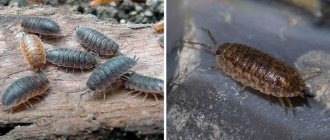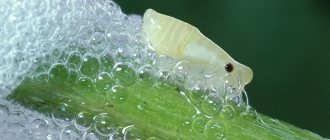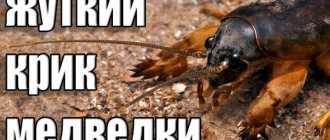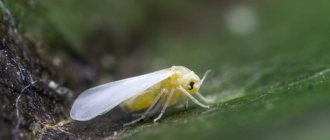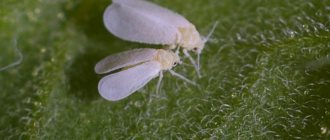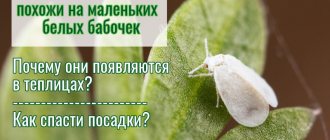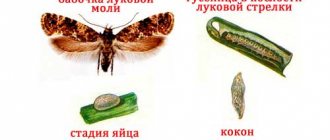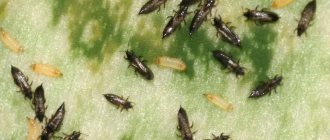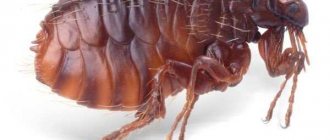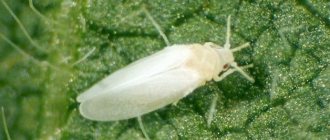A small white fly, which is very difficult to notice in the green foliage, is one of the most dangerous pests of flower and vegetable crops. It causes significant damage to them, quickly destroying indoor flowers or seedlings. The moth feels especially good in a greenhouse, where almost ideal conditions are created for it. Let's figure out how to get rid of whiteflies once and for all.
Description and types of whitefly
It is not so easy to see whiteflies - they have tiny sizes, from 1.3. mm. up to 2.5. mm. depending on gender. They are necessarily white or predominantly white in color - only this feature makes them noticeable on the soil of the pot and the flower itself; they resemble moths in appearance.
REFERENCE! Adult whiteflies cause a lot of harm - for example, they spread phytoviruses. But the larvae of these insects are much more dangerous for plants - they eat a lot and quickly, and also securely attach themselves throughout the plant, destroying it.
It is easier to detect whiteflies in motion - having settled on a flower, they actively move around it and hide when a threat appears. If you see an insect but are not sure, look at photos of whiteflies on houseplants from other gardeners.
Tobacco or cotton
The main danger of these insects is the transfer of viruses to a variety of plants - not a single flower can be insured against this. The most common type.
Greenhouse or greenhouse
It is possible that your pests are of this particular species - it is the second most common. These insects breed all year round and can easily be carried into your apartment by the wind.
Asian or citrus
Not very common, it can mainly be found in the Caucasus or the Black Sea coast.
Most likely you will find representatives of the first two species on your plants. They reproduce quickly, and adults run away from danger - which is why it is necessary to destroy them as quickly as possible from the moment of discovery.
Biological methods
Chemical preparations against whiteflies are gradually losing their relevance. Biological methods of control are being replaced. Examples:
- Placing encarsia pupae in greenhouses. The female parasite lays eggs in the bodies of whitefly larvae, which leads to death. Encarsia pupae are launched 2 weeks before planting.
- Macrolophus bug. Tobacco and greenhouse whiteflies are destroyed. These bugs are released before the active development of the pest. Against whiteflies, 1 insect per 1 m² is enough.
The colonization of greenhouses and greenhouses with entomophages is characterized by an efficiency of up to 99%. Biological enemies are especially useful for pests on tomatoes. Cucumbers contain hairs on the surface, which prevents entomophages.
Causes of pests
You don’t need to do anything specific for whiteflies to appear - these insects move with the wind, so they can settle completely by accident. Most often this happens in spring and summer, when the air is warm and the windows are open.
These parasites also infect the soil with their larvae - the eggs easily tolerate cold and begin to actively develop only in suitable conditions. To avoid this option, buy flower soil in a safe, sealed package, or take any soil, but process it at high temperatures.
Why does whitefly appear?
This pest can live anywhere - in greenhouse conditions, gardens, orchards, therefore:
- whiteflies can fly into an open window in spring or summer and will live on house flowers;
- the pest can be brought into the apartment with a new plant purchased in a specialized store or greenhouse, it is there that these “harmful” bugs can be found in large numbers;
- These insects can also enter the apartment along with soil components or when transplanting adult flowers.
Whitefly - method of fighting it with water - video
Important!
The eggs of this pest are not afraid of frost and quietly overwinter in the ground. Whitefly larvae begin to hatch from their eggs if they are placed in a warm, dry room. Therefore, after preparing a nutrient substrate from components that are stored from the garden, it should be disinfected - calcined in the oven, heated in a water bath or spilled with a weak solution of potassium permanganate.
In comfortable home conditions, a whitefly can live in an apartment for years.
How to detect
Whiteflies on indoor plants are noticeable due to their white color and chaotic movement. There can be a large number of adult insects on one flower at the same time, so you will most likely notice them quickly.
Most often, the pest hides under the leaves of the plant (if there are any - and the whitefly prefers deciduous species). Lift one leaf and shake it a little - the adults will scatter and you can see the small spherical capsules of the larvae. They are covered with a dense layer of waxy substance that protects them from almost any external influence.
Peculiarities of the pest's life
Whitefly is an extremely difficult pest to remove, very often appearing on indoor plants. Moreover, this parasite is also difficult to notice. The fact is that this parasite looks extremely inconspicuous. Externally, the whitefly is somewhat reminiscent of a moth, only in a special shade. This pest has a flat, flattened body. As for its color, much depends on the type of whitefly. But most often the pest’s body is pale, yellow-red, white or greenish.
Interestingly, the pest got its name thanks to its wings, the color of which is snow-white or cream. It is by these wings that you can identify the pest that has “visited” your plant.
Another peculiarity of the pest is that it is one of the few insects that react almost instantly to danger. As soon as you even slightly touch the bush on which these pests are located, they instantly take off and land back on the bush only if it is in a complete state of rest.
The danger of this pest lies in the fact that this pest is very voracious. No wonder they compare him to locusts. So if even one of your plants has been attacked by it, then immediately take control measures, and also carry out preventive measures for other plants in the house, greenhouse or garden.
Initially, this pest operated in the warm and humid climate of South America, but gradually, together with exotic plants, it moved to other countries of our planet. Today, the whitefly family includes more than 1,500 different species. Most of them prefer a warm and humid climate, the same as in their “homeland,” but if you live in a temperate or even cool climate, then you should not relax, because some types of whiteflies have become accustomed to surviving in difficult conditions.
However, most whitefly species are active exclusively in the summer, especially on plants located outside. As for the cold seasons, the pest prefers to survive them in the form of larvae and eggs, which the whitefly lays in secluded places.
It is almost impossible to find such places on purpose, so the best means of combating whiteflies is preventive measures. But do not forget that the pest is capable of operating in houses and greenhouses, and in such conditions it is capable of causing harm and multiplying all year round.
However, the main danger from the pest comes in the summer. It is during this period that the peak of reproductive activity occurs. For example, individual females are capable of laying almost 300 eggs at a time. Individuals are formed quite quickly. The first larvae will appear on your plant in just 10 days. And they do even more harm than adult larvae. They become adults in a month, sometimes in 20 days. And most importantly, as statistics show, almost all individuals survive until this period.
Thus, the pest can multiply to incredible numbers. Sometimes only one generation is capable of producing 2-3 cycles of offspring. This means that on just one plant the whitefly can be present in all its forms. The individual does not live long, about 3 weeks. But during this time she manages to do a lot of nasty things.
An interesting fact: despite the fact that the insect loves warm regions and warm seasons, intense heat simply kills the pest. For example, at air temperatures above 30°C, the lifespan of an insect is reduced to several days. A similar situation occurs at temperatures below +18°C.
Signs of plant infection
You don't have to look out for insects to understand that something is wrong with the plant. There are several signs of infection, having noticed which you can definitely start thinking about how to treat your plants against whiteflies.
The main signs of the appearance of parasites:
- The plant itself fades - it begins to wither and turn yellow for no objective reason. This happens because adult insects introduce viruses and leave honeydew (more on that below), and the larvae feed abundantly on the juices of the flower.
- Honeydew or honeydew appears on the leaves and stem - a sticky silvery-white coating secreted by adult insects. If there are such traces, then the pests have already firmly established themselves on the plant.
- White, and then black, spots on the leaves and stems from sooty fungus. This sign suggests that saving the plant will no longer be easy. Sooty fungus appears shortly after honeydew - their development is interconnected.
If you notice any of these signs, look for insects or larvae. As soon as your fears are confirmed, try to figure out what phase of reproduction the pests are in - this is critically important for controlling whiteflies on plants.
IMPORTANT! Be sure to isolate the plant as soon as you notice signs of infection - this is a necessary measure so that other flowers are not harmed. Whiteflies quickly invade neighboring pots as soon as the population becomes too large.
Larvae and adults require different measures for eradication - keep this in mind. First of all, try to destroy all adult insects - they multiply very quickly, and then tackle the larvae.
How to deal with whitefly on indoor plants - reviews from gardeners
Lyudmila Ivanovna, 51 years old, Leningrad region:
My husband and I have a greenhouse, so we know firsthand about whiteflies. When she appeared in the house, they immediately realized that fighting with proven methods was not suitable - environmentally friendly means were needed here. Therefore, we decided not to resort to chemistry. To repel and kill insects, I use an infusion of ash, and I also sprinkle shag dust on the plants. Whitefly eggs are much more difficult to destroy, sometimes it comes to the point that I wipe the leaves with a solution of ammonia. In the fall, I’m thinking of taking out all the tubs to disinfect the soil and destroy larvae and adult pests. This is how we fight.
Maria Epifantseva, 43 years old, Pskov region:
There are a lot of different plants in the house - it’s beautiful, but there’s also a lot of hassle with them. Even despite our rather harsh climate, there are a lot of different pests in the region, among them the whitefly stands out for its gluttony. Since I don’t have extra time to care for plants, I fight pests using chemicals. In the spring, I take all the tubs and pots out onto the veranda, open the windows and treat them with Fitoverm at least twice with an interval of 7-8 days. In winter and early spring I water the soil with a weak solution of Aktara. As a rule, after using it for several days, all pests die.
Advantages of using Aktara insecticide : effectively controls the population of adult whiteflies, as well as their eggs and larvae, the drug can be used both for spraying and for watering plants, no unpleasant odor, affordable price;
Disadvantages: when processing plants, you must follow personal safety rules; it can harm bees and other beneficial insects.
Chemical treatment
To successfully combat whiteflies on indoor plants, reliable chemicals have long been invented - all you have to do is select and apply them correctly. Many gardeners are afraid that the chemicals will damage the plant, but all insecticides that are used to kill whiteflies are designed to have minimal impact on house flowers and other cultivated plants.
Most of the products that will help you kill these parasites are long-acting - this is necessary, since some whiteflies can survive after treatment, and this is enough to restore the colony. Having chosen a drug, use it exactly according to the instructions, observing the dosage - you need to destroy the entire population at one time.
Aktara is considered the best insecticide against whitefly.
This drug is used most often - flower growers choose it due to its long-lasting action and prevention of re-infection for almost a month. It has a complex effect - after watering, it impregnates the plant and its juices, which the parasites feed on, with a deadly poison for them. The entire colony dies within a week or 10 days - you don't need to do anything for this.
Traditional methods
Gardeners and summer residents in their small plots prefer to cope with the invasion of the parasite using traditional methods. The advantage of these methods is the absolute environmental friendliness of the fruit.
- An effective method is wiping with water. But the method is only suitable for indoor plants and a small number of seedlings. Take a sponge, soak it in water and wipe the leaves with it. The method is painstaking, but you know for sure that all the larvae have been removed.
- The composition of water and laundry soap is prepared in the proportion of 1 part soap to 6 parts water. Water the soil, but not too much, so as not to harm the roots and plant. Repeat in a week.
- Garlic tincture is prepared from 2 large cloves of garlic and 1 liter of hot water. Leave it to sit overnight and then you can spray it on.
- Yarrow tincture is prepared at the rate of 90 g of leaves per 1 liter of water. Let it brew for 2 days and spray the plants or seedlings. Repeat 3 times every other week.
- Tobacco solution. Experienced gardeners recommend using Prima cigarettes. The tobacco from them is poured into a jar and filled with water. Let it brew for 5 days, strain and spray. Repeat the treatment until the midges completely disappear.
- Dandelion tincture is prepared from 40 g of leaves, 40 g of roots, which are crushed and filled with water. Let it brew for 4 days, strain and process the plants.
- Ammonia is diluted 35 ml per 1 bucket of water. Treatment with ammonia is carried out every 3 days.
- Birch tar is part of tar tincture. Dilute 5 ml per 10 liters of water.
- The vinegar solution is prepared as follows: take 5 tablespoons per 10 liters of water. vinegar essence.
It is difficult to say which varieties of petunia, house rose or fuchsia are resistant to whitefly. But in order not to look for something that doesn’t exist, it is best to use preventive measures and fertilize plants with nitrogen compounds.
Other effective drugs
Spark
An insecticide identical in action to Aktara. Valid for 25 days.
Confidor and its analogues
Not only kills the main colony after watering, but also has a contact effect (only against adult insects).
Akarin
Contact and food poison for whiteflies. You should not relax immediately after treatment - you need to monitor the plant for some more time to make sure that the whitefly has died as a whole in the colony. Relapses often occur, to which it is worth responding just as quickly.
Harm from parasites
Damage is caused by all stages of butterfly development, except eggs . The larva feeds on plant sap, weakening them. Such flowers stop developing and begin to wither and dry out.
Adults do not feed on sap, but they pollute plants with their excrement, which are subsequently attacked by sooty fungus.
It causes the affected parts to turn black and rot. In addition, whiteflies carry dangerous viruses that cannot be treated. First of all, these are chlorosis , viral mosaics , jaundice and leaf curl .
ATTENTION! Sick plants infected with viruses are the easiest to dispose of.
Non-chemical plant treatment
If you don’t have a chemical on hand, and you need to start understanding how to deal with whiteflies on indoor plants now, you can try methods that do not involve insecticides.
First, try to clean the plant mechanically - take it out into the open air and carefully shake off the adult insects, then take the pot away. Of course, you won’t be able to kill the entire colony this way, but you will improve the situation. Do not try to remove the larval cocoons - they are securely attached to the leaf, so you will only scratch the plant.
Another option is glue traps. Whiteflies are very light insects, so even a small layer of glue will be fatal to them. Traps can be purchased or made; bright yellow is recommended. You don't need to do anything - just place a few in and around the pot, the pests will stick to it on their own.
How and when to treat the area?
The area must be treated at a certain time. This way the effect will be higher, and the whitefly will disappear from the area faster.
On vegetable crops
If an insect appears on vegetable crops, you first need to use folk recipes, and only then use chemicals. This will protect the flowers and stems of the bushes from harmful substances entering the plant. It is best to spray vegetables, but you can also water the soil with the solution.
You need to use control methods on a quiet day that does not predict precipitation or strong winds. Also, do not spray plants with chemicals on a hot day, as burns may occur on the leaves. Treatment should be carried out at the moment the whiteflies appear, without waiting for their reproduction.
On flowers
Flowers should not be treated with chemicals that are absorbed into the plant, as the flower may wither. It is best to process flower stalks when flowers have not yet begun to form on them. At the same time, whiteflies should not be allowed to reproduce.
Flowers also need to be sprayed with solutions or watered the soil around them.
On bushes and trees
Trees and bushes, due to their large size, are recommended to be pollinated with chemicals. They will destroy harmful insects that have hidden under the bark or in other hard-to-reach places. You need to spray the plant before flowers or fruits appear on it.
The best folk remedies for whiteflies
There are also effective folk remedies - with them, the fight against whiteflies is possible even on indoor plants with increased sensitivity to treatment. The first place to start is with processing and cleaning. Drive away as many insects as you can and start removing all the affected parts of the plant - leaves and shoots in the fungus. Remove honeydew too.
The most popular folk methods.
Garlic infusion
You need three cloves of garlic and a liter of boiling water - mix it and leave it in a dark place for a day. Spray the plant well with this liquid from a spray bottle, without watering it under any circumstances.
Soap solution
Prepare it carefully - you only need one tablespoon of grated soap and 6 liters of water. Reduce the proportions to the required level and spray; watering is also strictly forbidden.
Dichlorvos
Do not spray the plant directly, it is very harmful. Soak a piece of cotton wool in the chemical, place it in the pot and place the flower in a bag or bag that can be tied. After tying it, leave it for five hours.
If this does not help, it is recommended to return to insecticides - it is better to risk the health of the plant a little (although the likelihood of this is exaggerated) than to risk losing it completely.
How to recognize the presence of a pest
The structure of the oral apparatus of this insect is a thin chitinous proboscis , with which it pierces the leaf blades and sucks the juice from them. It is in the wake of this vigorous activity that it becomes noticeable that vegetable plants are being precipitated by whiteflies.
Externally, signs of damage look like this:
- the leaf plate of greenhouse crops is covered with yellowish dots less than a millimeter in diameter;
- gradually there are more dots, the leaf begins to fade;
- on the reverse side of the leaf blades you can see a sooty coating;
- On healthy leaves, clutches of yellowish small (up to 0.25 mm in length) eggs laid out in circles are found.
If there are a lot of insects, the surface of the leaves is literally covered with the products of their vital activity - honeydew, which is the excrement of whitefly aphids. It becomes a kind of soil for fungi.
That is why the lack of insect control can lead not only to weakening of crops, but also to massive damage to vegetable plants by fungal infections.
Processing rules
Depending on the substance, one of the treatment methods is selected - watering or spraying. Most insecticides work in the first way - in order to saturate the plant and kill numerous larvae, folk remedies, on the contrary, usually require spraying.
Often these measures intersect with each other in a variety of processing methods. Experienced gardeners advise not to neglect spraying in any case.
Prevention measures
You won’t be able to completely protect your flowers from the possible appearance of whiteflies - but you can do everything possible. The best thing you can do to keep your houseplants safe is to install mosquito nets.
IMPORTANT! It is highly likely that you will get whiteflies if you grow tomatoes at home - these pests love them very much. Try to keep such seedlings away from flowers.
It is not worth treating plants with chemicals prophylactically - this can be harmful. Try to inspect the flowers more often. As soon as you notice several individuals, be sure to kill them - this way you can prevent the emergence of a colony.
Preventive measures
To prevent the appearance and spread of whiteflies, you must adhere to the following recommendations:
- Do not plant bushes close to each other;
- Plantings must be ventilated to avoid air stagnation;
- Adjust humidity:
- Use biostimulants that strengthen the immunity of flowers;
- Fertilize the soil.

